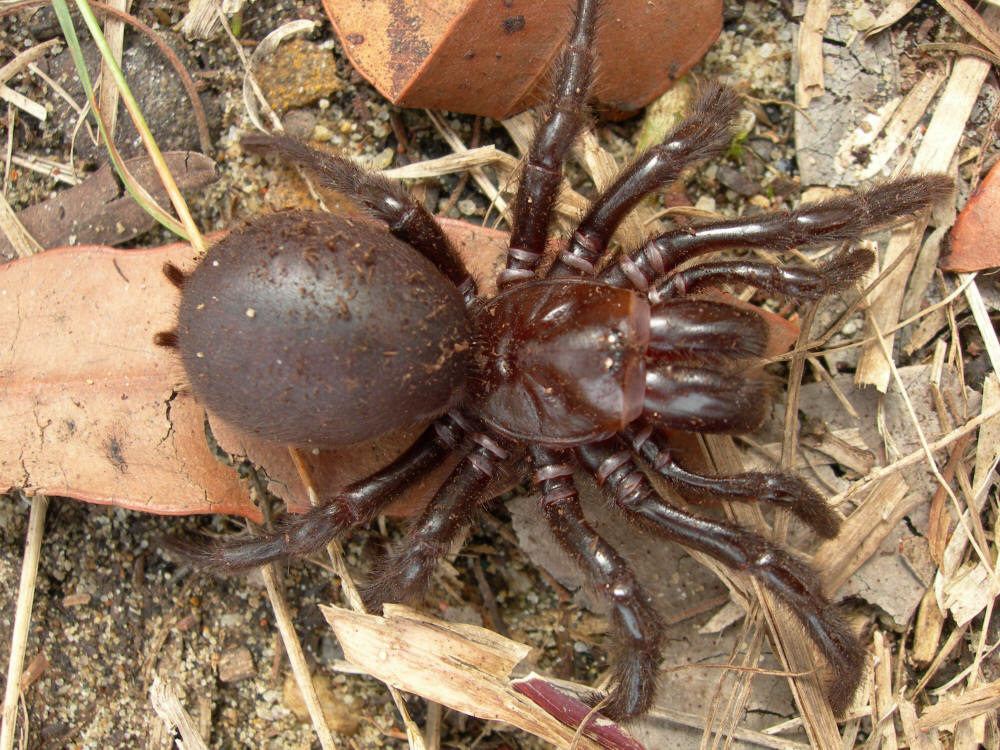Atrax robustus has to survive in some pretty harsh conditions, and even though it's a highly toxic species, which can make it seem intimidating, there are plenty of threats to it. Add to that the fact that, hey, a spider needs to eat, and you can see why the Sydney Funnel-web needs to be finely adapted to its environment. This being the case, the Sydney Funnel-web has some interesting and effective adaptations to help it succeed in its unforgiving lifestyle.
The first of these
adaptations are its legs. Funnel-webs don't rely on trapping their
prey in a web to immobilize it. Instead, they hunt by aggressively
attacking their victims. In fact, the Sydney Funnel-web is one of
the most aggressive spiders in the world! (See
![]() )
As such, they have sturdy, relatively powerful legs as spider legs go.
This trait is typical of the Mygalomorphs. (Foelix 22) The muscle
cells of spiders have low numbers of mitochondria, the cellular
organelle responsible for supplying cells with energy in the form of
ATP. As a result, spiders are capable of intense levels of
activity for short periods of time, but tire quickly. (Foelix 26)
This is especially important for A. robustus because it must
strike quickly from its burrow in order to capture prey. An
interesting fact is that spiders extend their legs via hydraulics, that
is, they increase the pressure of a substance called hemolymph within
their bodies using muscles in their carapaces. (Foelix 26)
)
As such, they have sturdy, relatively powerful legs as spider legs go.
This trait is typical of the Mygalomorphs. (Foelix 22) The muscle
cells of spiders have low numbers of mitochondria, the cellular
organelle responsible for supplying cells with energy in the form of
ATP. As a result, spiders are capable of intense levels of
activity for short periods of time, but tire quickly. (Foelix 26)
This is especially important for A. robustus because it must
strike quickly from its burrow in order to capture prey. An
interesting fact is that spiders extend their legs via hydraulics, that
is, they increase the pressure of a substance called hemolymph within
their bodies using muscles in their carapaces. (Foelix 26)
Another interesting ability of A. robustus is its ability to pop its limbs off of its body. That's right! As a means of defense against its enemies, a spider may deliberately separate one of its legs from its body! Naturally this is a last resort. According to Foelix, the process is referred to as "autotomy". Most spiders can do this, so it's not an exclusive ability of A. robustus, but it's still pretty cool! As a matter of fact, most arthropods can do it as well. (Foelix 229) Fortunately for the spiders, they are able to regenerate their lost limbs. The new limbs are not always as good as the old ones, but at least they get their legs back! (Foelix 231)
Perhaps the attribute of A. robustus that best adapts it to its life as a hunter are the many small hairs that cover its body and legs. These hairs are specialized to sense the stimuli in the environment of the Sydney Funnel-web. (Foelix 26) Most of the really important hairs are located on the spider's legs. Some of the hairs, called sensilla, are specialized to detect touch and vibration. These types of receptors are called mechanoreceptors. The most finely tuned of these hairs are the trichobothrium, which can detect air currents and low-frequency air vibrations. (Foelix 26-28) The spider's legs are also equipped with chemosensory hairs which allow the spider to detect the chemical characteristics of a substrate simply by walking over it! (Foelix 28) Some of these hairs are specialized to detect humidity, and are called tarsal organs. (Foelix 29) The multiple eyes present in A. robustus are of little consequence in prey capture because the spider relies primarily on detection of vibrations and air currents to sense its prey. (Foelix 163)
Are you beginning to see why Atrax robustus is such a capable predator?
This site was last updated 04/25/08
